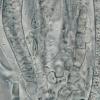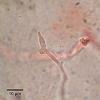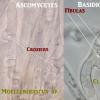
05-07-2013 07:17
Nina Filippova(15.06.2013)The litter of Marsh clover (Menyanthes

04-07-2013 23:29
 Zuzana Sochorová (Egertová)
Zuzana Sochorová (Egertová)
Good evening,in spring I found these small ascomyc

04-07-2013 14:02
Dear friends Under a melanized, epidermial blacki

04-07-2013 06:10
Nina Filippova(10.06.2013)Surprisingly, litter of Eriophorum rus

02-07-2013 01:09
Moving on from the possible S legaliae there was t
Croziers ?
Michel RIMBAUD,
27-06-2013 09:15
Je rencontre le terme "croziers" dans la littérature et sur les sujets de forums Asco.
Qu'est ce que c'est exactement ? je sais que ça se trouve au pied des asques mais je n'en connais pas la définition et je n'en ai jamais vu.
Je ne trouve pas ce terme dans les différents glossaires de mycologie, sauf celle-ci dans wikipedia : http://en.wikipedia.org/wiki/Crozier_(mycology)
Quelqu'un peut-il montrer une image de ce qu'il faut voir à la micro ?
Merci de combler mon ignorance.
Michel
Michel Hairaud,
27-06-2013 09:52

Re : Croziers ?
Bonjour Michel,
Je t'adresse en privé un extrait du papier de René Dougoud récemment paru dans Ascomycete.org , relatif à l'étude des asques. Tu y trouveras je pense une bonne explication pour les crochets ( = croziers) .
En complément, tu pourras regarder dans la base de données un certain nombre de fiches, notamment celles d'Enrique Rubio sur des Helotiales, il met souvent très bien en évidence la base des asques et donc la présence de crochets s ils sont présents.
Je reste à ta disposition pour davantage si tu le souhaites.
Amitiés
Michel
Je t'adresse en privé un extrait du papier de René Dougoud récemment paru dans Ascomycete.org , relatif à l'étude des asques. Tu y trouveras je pense une bonne explication pour les crochets ( = croziers) .
En complément, tu pourras regarder dans la base de données un certain nombre de fiches, notamment celles d'Enrique Rubio sur des Helotiales, il met souvent très bien en évidence la base des asques et donc la présence de crochets s ils sont présents.
Je reste à ta disposition pour davantage si tu le souhaites.
Amitiés
Michel
Michel RIMBAUD,
27-06-2013 21:00
Re : Croziers ?
Merci Michel,
J'ai lu le document, je crois avoir compris.
J'ai regardé les images des Helotiales par Enrique. Je crois avoir vu ce que c'est, mais ça me semble bien difficile à observer. J'essayerai.
Michel
J'ai lu le document, je crois avoir compris.
J'ai regardé les images des Helotiales par Enrique. Je crois avoir vu ce que c'est, mais ça me semble bien difficile à observer. J'essayerai.
Michel
Raúl Tena Lahoz,
28-06-2013 00:09
Michel RIMBAUD,
28-06-2013 07:29
Re : Croziers ?
Bonjour,
Ah oui, superbe !
Merci encore à Michel, Raul, et Enrique.
Michel
Ah oui, superbe !
Merci encore à Michel, Raul, et Enrique.
Michel
Martin Bemmann,
01-07-2013 21:52
Michel Hairaud,
01-07-2013 22:22

Re : Croziers ?
Yes indeed, Martin.
Thanks
Michel
Thanks
Michel
Michel RIMBAUD,
07-07-2013 10:38
Re : Croziers ?
Very surprising and interesting,
Thanks to all.
Michel
Thanks to all.
Michel






